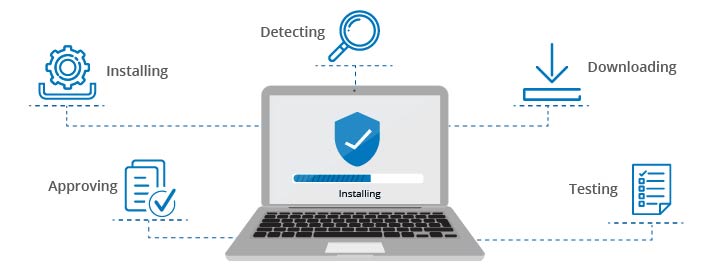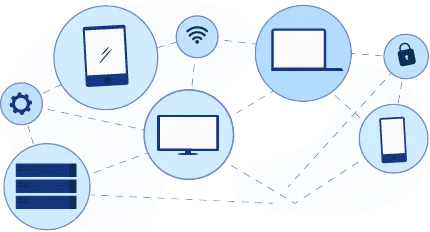To stay on top of the large number of patches released every day, you need an effective patch management software. Endpoint Central offers a fully automated patch management system for Windows, Mac, Linux and third party applications (view the complete list of supported applications here). The following capabilities give you granular control over the entire patch management process and enable you to keep your endpoints secure and up-to-date:
Zoho Corp continuously probes the internet for newly released patches and vulnerabilities. Once a new patch is discovered, it is added to Zoho Corp's Central Patch Repository after ample verification and testing. This repository can be accessed by Endpoint Central server installed within a client's environment and is used to evaluate vulnerabilities within the network.
On the client's site, the server maintains a Vulnerability Database which is synced periodically with the Central Patch Repository. This sync is done in two ways:
A patch scan is automatically initiated every time the vulnerability database is updated. All systems in the network will be scanned for missing patches within the next 90 minutes and this data will be posted to the server.
Endpoint Central allows you to classify the health status of the systems within your network via the system health policy. You can specify the number of missing patches for which the systems should be classified as healthy, vulnerable and highly vulnerable. Based on this classification, you will be able to narrow down the systems that need immediate attention and take effective measures.
Endpoint Central also helps automate antivirus definition updates. Such updates are quite frequent and may happen several times a day which might result in high bandwidth consumption. To avoid it, you can schedule these updates once every day at a convenient time.
You can disable automatic updates in just a few clicks. This allows you to have complete control over any updates that are installed within your network.
It is always recommended to test patches before installing them on all the systems in your network to ensure that there is no downtime due to faulty patches. You can form test groups and automate installation of patches on test systems before rolling them out to the entire network. You can also specify the number of days after which the patches should be approved automatically for installation on the rest of the systems.
You can choose to decline patches for certain applications (legacy applications) or in case there's a patch that causes instability while it's installed on test systems. Endpoint Central allows you to decline non-severe patches as well as patches for a specific group of computers.
To avoid bandwidth issues and ensure system availability, system administrators can schedule the installation of patches on a convenient day and time by configuring a deployment policy. In the deployment policy, you can configure the week(s) and day(s) on which the deployment should take place, the time interval within which the patch should be installed, and the reboot policy. You can also allow the user to skip deployment. The product has the capability to wake computers on LAN before deployment, if the computers are shut down at that moment.
You can automate patch deployment every step of the way and save time, resources and effort. You can automate it for specific applications or departments within your network, on the desired day and time, at a convenient frequency. You only need to schedule it once, and the entire process will be automated and you will be notified at each step. Visit this web page to know more about this.
You can manage patches on the go with our mobile app. In just a few taps, you can install software patches, approve/decline patches, view detailed patch reports, initiate patch scanning and much more! What's better is that you don't even have to do these tasks yourself, just ask Zia, Endpoint Central's IT Assistant, and she'll do them for you.
Patch Management is the process of detecting, downloading, testing, approving and installing new/missing patches for all the Operating Systems and applications within a network. It entails having a centralized view on the applicable patches for endpoints across a network, so that Vulnerable, Highly Vulnerable and Healthy Systems can be classified at a glance. This helps spot the systems that need attention so that appropriate measures can be taken to keep the network safe from cyberattacks.

Cyber crime has increased exponentially in the past decade, with hackers becoming more and more creative and coming up with new ways to exploit vulnerabilities. One of the most common entry points for these attacks are unpatched systems. Every time a security patch is released, the attackers become aware of a new vulnerability that can be exploited (in unpatched systems) and they start probing networks for the weakness.
Since only 38% of the organizations are prepared for a cyberattack, such vulnerable networks are easy to come across and exploit. This is why an effective patch management software is required, to keep networks safe from cyber attacks and prevent data breaches.
An IT admin who manages 1000 endpoints will have countless things to keep track of and patches will be on the top of the list. When an IT admin is handling numerous endpoints with multiple operating systems, it translates to diverse applications that will require patching. Patch management facilitates an admin to handle patches based on the threats and their severity for individual operating systems from a centralized location.

If you are looking for an exclusive MSP-centric solution for patch management, try Endpoint Central MSP today!
Free, 30-day trial